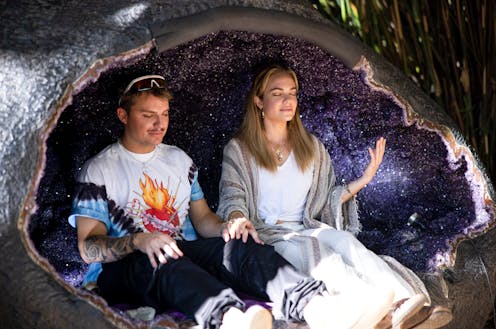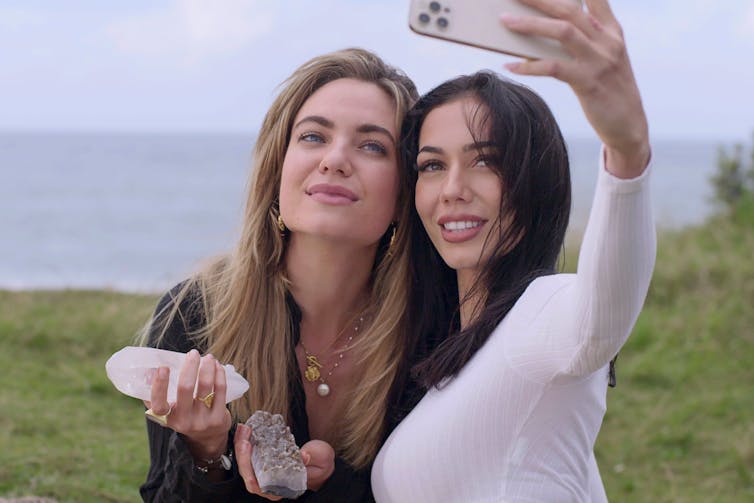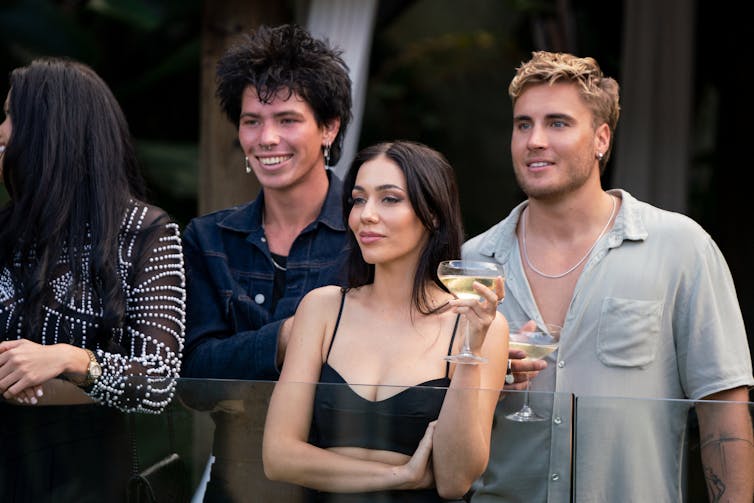Source: The Conversation (Au and NZ) – By Phoebe Macrossan, Lecturer in Screen Media, University of the Sunshine Coast

Ben Symons/Netflix © 2022
Netflix’s first ever Australian reality docu-soap series Byron Baes follows a bunch of young, beautiful Instagram influencers in NSW beachside town Byron Bay.
As a reality series it ticks all the boxes for compelling content: picturesque trendy location, young conventionally-attractive (and slightly self-absorbed) cast, and a revolving schedule of fancy parties, fashion shows, product launches and competing love interests that let emotions spill over.
Throw in a side of alternative health and wellness, crystals, and performative caring about the environment that comes with Bryon and you have a cringe-filled but binge-worthy watch.
But while the show might be an easy watch, it’s worth thinking about what exactly goes into that Instagram-perfect “reality” television.
The ordinary celebrity
Discovering the “ordinary” person behind the big movie star has always driven narratives of fame. This is why magazines run exclusive in-depth interviews with Nicole Kidman and ask about her marriage, kids and cake recipes – to give us the behind-the-scenes look at who she “really” is.
This has been happening since the Golden Age of Hollywood. During the first half of the 20th century, fan magazines worked with studios to provide upbeat coverage of Hollywood stars’ “ordinary” lifestyles, hairstyles and love lives.
In recent years, social media has encouraged everyday people to engage in celebrity practices online. Everyone who posts on Instagram is consciously aware of an audience, and curates their content for their followers in the same way a celebrity would for their fans.

Courtesy of Netflix © 2022
Instagram influencers – like most of the cast of Byron Baes – have turned this into a business model. Influencers build a brand and a following (much is made of Jade’s 1.2 million Instagram followers) then get paid by companies for sponsored posts or collaborations.
Byron Bay is host to big movie stars like the Hemsworth brothers but is also now believed to have more social influencers per capita than any other town in Australia.
The fact that many Australian viewers will have visited Byron Bay (or at least know of it) and definitely know someone who can be a bit “extra” on Instagram adds another layer of familiarity.
Read more:
Friday essay: why there’s still something about Byron, beyond Insta influencers and beige linen
Crafting the narrative
Reality television is, as the name suggests, sold on the basis of being a representation of “reality”.
New forms of stardom and celebrity created in reality television and on social media rely on the performance of “authenticity”: the idea that somehow we are seeing “real” people and accessing their true authentic self.

Paul A. Broben/Netflix © 2022
In Byron Baes, this is helped along by the fact that a lot of these influencers are into wellness and spirituality – spheres where authenticity and being true to oneself are highly valued.
The fact is, of course, that Instagram and reality shows are just as manipulated, scripted and filtered as any fictional series or doctored photographic image.
Reality television constructs the illusion of authenticity through the idea it offers immediacy, intimacy and closeness. We often see reality television stars in extreme displays of emotion: losing their cool, rolling their eyes, bitching behind someone’s back, or confessing their secret love.
We are invited into their homes and businesses. We see photos of them as children, meet their parents and hear their struggles with bullying, loneliness and self-doubt.
The low-fi, offhand nature of the handheld camera footage and the direct one-on-one interviews where the cast speak directly to the camera calls on notions of the “real” associated with documentary genres. These one-on-ones are the show’s attempt to convince the audience these are genuine moments of real emotion behind the scenes – not staged for the camera.
But even the casting is an act of manipulation. There are types producers tend to cast: ones that cause drama and stir the pot (Alex, Jade); ones that bring energy, keep the story moving and are natural on camera (Jess, Nathan, Saskia); ones who are a little bit kooky and add flavour (Cai, Heather, Simba); villians (Elle) and heroes (Sarah) – and models (Elias) who just look really really good on camera.

Paul A. Broben/Netflix © 2022
Manipulating our perceptions
The beauty of reality television is that everything anyone says is captured on camera. When Elle denies calling Sarah fake, the series can conveniently cut back to the moment it happened.
Of course, this never happens in real life, so viewers delight in the delicious justice of a “real life” person being caught in a lie.

Paul A. Broben/Netflix © 2022
The producers can also manipulate our own perceptions of Elle by showing us one-on-one interviews where she describes herself as “one of the most generous, loving, open-hearted people that I know,” then follows up with “if someone dishonours me, I certainly wouldn’t want to be them.”
For viewers, while these manufactured conflict storylines make for dramatic content (there’s also a handy feud between Nathan and Elias over Sarah, and Jade and Alex over Instagram followers), the real appeal is in the illusion that these people are “just like us”.
Despite the community backlash during filming and mixed reviews, Netflix’s gamble on a Byron reality show paid off.
But while getting swept up in this “reality” it is worth remembering that, much like an Instagram filter, just because something is presented as real, it doesn’t mean it is “authentic” – a notion which is itself, just as constructed.
![]()
Phoebe Macrossan does not work for, consult, own shares in or receive funding from any company or organisation that would benefit from this article, and has disclosed no relevant affiliations beyond their academic appointment.
– ref. From cringe to binge: the ingredients that make Byron Baes compelling reality television – https://theconversation.com/from-cringe-to-binge-the-ingredients-that-make-byron-baes-compelling-reality-television-179284







